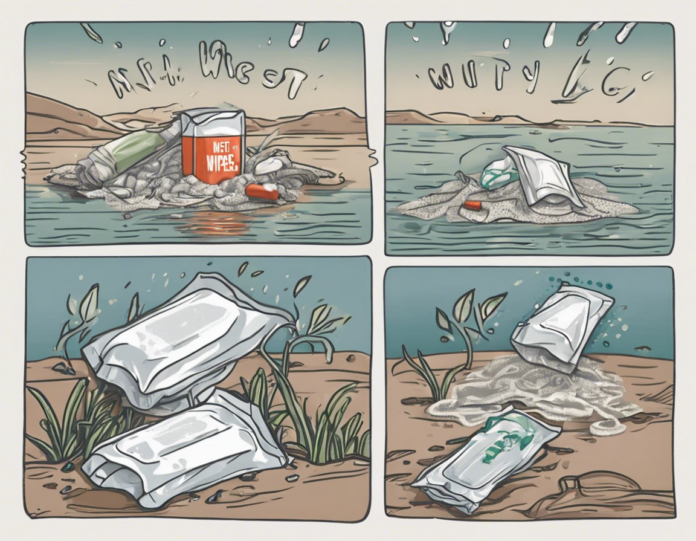Plastic pollution has become a pressing global issue, prompting significant discussion and action towards reducing our reliance on single-use plastics. Wet wipes, a common household item used for personal hygiene and cleaning purposes, are a significant contributor to this problem due to the non-biodegradable plastic fibers they contain. As a result, there is a growing momentum towards banning plastic in wet wipes and finding more sustainable alternatives. In this article, we will delve into the environmental impact of wet wipes, the challenges associated with banning plastic in this product, and potential solutions for a more eco-friendly future.
The Environmental Impact of Wet Wipes
Wet wipes are convenient products that offer quick and easy solutions for various tasks, from cleaning surfaces to personal hygiene. However, the majority of wet wipes in the market contain plastic fibers such as polyester or polypropylene, making them non-biodegradable. When flushed down toilets or disposed of improperly, these wipes can end up in water bodies, contributing to marine pollution and posing serious threats to aquatic life. The presence of plastic in wet wipes also means that they persist in the environment for hundreds of years, further exacerbating the issue of plastic waste.
Apart from the plastic content, wet wipes may also contain harmful chemicals such as parabens and phthalates, which can have adverse effects on both the environment and human health. As a result, the environmental impact of wet wipes extends beyond plastic pollution, highlighting the need for more sustainable alternatives.
The Challenges of Banning Plastic in Wet Wipes
While banning plastic in wet wipes seems like a straightforward solution to address their environmental impact, several challenges need to be considered. One of the primary obstacles is the lack of viable alternatives that can match the convenience and effectiveness of traditional wet wipes. Consumers have come to rely on the durability and moisture retention properties of plastic-based wipes, making it crucial to find substitutes that offer similar performance without compromising on quality.
Additionally, the cost implications of transitioning to plastic-free wet wipes can be significant for manufacturers, potentially leading to higher retail prices for consumers. Balancing environmental concerns with economic considerations is essential to ensure the successful implementation of any ban on plastic in wet wipes.
Potential Solutions for a More Sustainable Future
Despite the challenges involved, there are several potential solutions that can pave the way for a more sustainable future for wet wipes:
1. Biodegradable Materials: Research and development efforts are underway to create wet wipes using biodegradable materials such as bamboo fibers or wood pulp. These alternatives break down more easily in the environment, reducing the long-term impact of wet wipes on ecosystems.
2. Water-Activated Wipes: Water-activated wipes that dissolve after use provide a promising alternative to traditional wet wipes. These wipes eliminate the need for plastic fibers and are more environmentally friendly, offering a practical solution for reducing plastic pollution.
3. Reusable Wipes: Encouraging the use of reusable wipes made from washable fabrics can help minimize waste and reduce the reliance on single-use disposable products. This approach promotes sustainability and long-term cost savings for consumers.
4. Regulatory Measures: Governments and regulatory bodies can play a crucial role in enforcing bans on plastic in wet wipes and incentivizing the adoption of eco-friendly alternatives. Setting clear guidelines and standards can drive industry-wide changes towards more sustainable practices.
5. Consumer Education: Raising awareness about the environmental impact of wet wipes and encouraging responsible disposal practices can empower consumers to make informed choices. Educating the public about the benefits of switching to plastic-free alternatives can drive demand for more sustainable products.
Frequently Asked Questions (FAQs)
1. Are all wet wipes made of plastic?
While not all wet wipes contain plastic fibers, the majority of conventional wipes on the market do contain some form of non-biodegradable plastic material.
2. Can wet wipes be recycled?
Most traditional wet wipes are not recyclable due to their plastic content. However, some brands offer recyclable or compostable options that can help reduce waste.
3. Why are wet wipes a concern for the environment?
Wet wipes contribute to plastic pollution when disposed of improperly, posing threats to marine life and ecosystems. Additionally, the chemicals and preservatives in some wipes can have harmful effects on the environment.
4. What are some eco-friendly alternatives to traditional wet wipes?
Eco-friendly alternatives to traditional wet wipes include biodegradable wipes, water-activated wipes, and reusable cloth wipes that minimize environmental impact.
5. Are there regulations in place to address the issue of plastic in wet wipes?
While some regions have introduced regulations to limit the use of plastic in certain products, there is still a need for more comprehensive policies and enforcement to address the environmental impact of wet wipes.
In conclusion, the future of wet wipes lies in embracing sustainable practices that prioritize environmental conservation and minimize plastic waste. By advocating for bans on plastic in wet wipes, promoting the adoption of eco-friendly alternatives, and raising awareness among consumers, we can work towards a cleaner and healthier planet for future generations.












